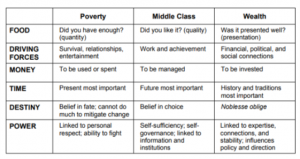Reading about the differences in consciousness and thought processes between literate and oral cultures is fascinating. I experienced the “aha” moment that always accompanies a change in perspective. But there is a difficulty with different; it inevitably leads to dichotomies and black and white thinking. This reading and the shift in perspective reminded me of the work I have done over the years with at risk youth. Dr. Ruby Payne in Bridges out of Poverty outlines a conceptual framework around poverty and the cultural differences that exist between people from generational poverty, middle class, and wealth. In it she categorizes the fundamental cultural differences in the way in which we think about time, money and relationships to name a few (Payne, 1999).

This illustration is useful for the aha moment, that realization that your perpetually late student has a radically different concept of time, and to help you check your biases. But she also discusses the hidden rules of each of the three ‘classes’ and suggests that the hidden rules of the middle class must be overtly taught to the students living within the culture of poverty. This is where the danger lies. Overtly teaching the hidden rules of the middle class to “help” this student learn or to function in a “better” way, is based on false assumptions. It assumes that the student is deficient in some way and seeks to “improve” his or her worldview rather than making the assumption that it is the institution that is deficient and in need of change. This begs the question: is the culture of poverty and the culture of wealth a dichotomy or does the overt teaching of the hidden rules of the middle class to the poor represent the process of continuity, or the ability to move from one state to the next? Is the primary function of school to transform thinking and to perpetuate cultural norms a values? If so, transform and perpetuate to whose values and norms? Graff (1987) suggests schooling is there to implement social control in the interests of ruling elites (cited in Chandler, 1995). Different is neutral and begs understanding. Rich and Poor is dichotomous and begs labeling. What role does mediation play?
Chandler, in “Biases of the Ear and Eye” particularly captured my attention because his thoughts appeal to my thinking about and change and continuity. He calls for a “need to consider the overall ‘ecology’ of processes of mediation in which our behaviour is not technologically determined but in which we both use a medium and can be subtly influenced by our use of it” (Chandler, 1995). If, as Ong suggests, there is a there is a cognitive difference in oral vs. literate cultures, the difference does not equate to a deficit in cognitive ability. As Graff (1987) points out, in this thinking there exists a tyranny of conceptual dichotomies wherein dichotomies preclude contextual understanding and ignore the role of reciprocal interaction ( cited in Chandler, 1995).
Why do you think that the uptake of educational technology has been so slow? Does deterministic thinking guide teaching practice and institutions and preclude the reciprocal interaction required for technological integration? The push-back for technological integration is multifaceted but the urge to teach what we know weighs heavily in this argument. There are two perspectives to consider here: looking at the “problem”, as an opportunity to transform, collaborate and inquire, or the “problem” as a deficiency, something to avoid, suggesting a lack of professionalism. The process of reflection and revision does happen in teaching of course, but the reflection can be egocentric, and isolationist, motivated by the sage on the stage mentality. The merits of the continuity theory when applied to educational technology and combined with the first perspective or approach to the “problem” stands to fundamentally transform the way we educate in the future.
References
Chandler, Daniel (1994): ‘Biases of the Ear and Eye: “Great Divide” Theories, Phonocentrism, Graphocentrism & Logocentrism’ [WWW document] URL http://www.aber.ac.uk/media/Documents/litoral/litoral.html
Ong, W. J., & Hartley, J. (2012). Orality and literacy: The technologizing of the word. London: Routledge.
Payne, Ruby (1999) Bridges out of poverty: Strategies for professionals and communities. (1999). Highland, TX: RFT Pub.





EdPawliw
June 21, 2018 — 12:13 am
Hi Wendy
Very interesting post. I found myself making notes and looking for responses for your questions that could reconcile these questions at least on one level.
One of your questions, “What role does mediation play?”, requires one to specify what definition of mediation one may be using. I will focus on to bring about as opposed to an intervention. As an educator, I would say that we are mediating empowerment. Instead of teaching empowerment, we set our students up to experience and discover it through constructed learning they drive, such as in self-directed projects. While some may not have entry skills to undertake these, this is where the teacher mentors the learner through the process, at least initially. We could think of this as a door ding. Where the technician uses various spoons and dry ice to massage the dent out and shrink the metal back to shape, so we use our technology and training to assist the student through the empowerment project. Here is where we have to then step back. Once given the tools, it is up to the individual initiative of the student to use or discard the empowering tools. They must be the agent of their own power level change.
As a teacher, we are a power mediator. Our goal is to provide tools to equalize power imbalance. In a sense we are removing the power structures of the literary elite and setting a more even playing field. An open source society (sorry Apple, you would have no place in this philosophical utopian state) would also help to reduce power imbalance by removing control of published materials. As Ong states, the elite and the Church had immense power due to their control of written works. He has shown us how this was equalized with the industrialization of printed works.
Your questions “Is the primary function of school to transform thinking and to perpetuate cultural norms a values? If so, transform and perpetuate to whose values and norms? “ speaks to the heart of the philosophical structure of society. One could take a relativistic view. This being, it would boil down to what are the norms and values of society that the educational context is wrapped in and that the teacher has been tasked with working under. For instance, I teach in a Catholic school system. We have non-Catholic teachers in our district. Condition of employment is that they conduct themselves, in their role as a teacher in our school district, within the norms, values, and tenets of the Catholic religion. Generally though, we operate in our roles under the values and norms as set out by the society of the day. We are operating under the guise of in loco parentis, taking the place of the parent, and under the umbrella of a community set of standards, educating young members of that society. This means we must be sympathetic and responsible to these standards without compromising our own power and position in society. For without that, we no longer have the mandate to teach.
The statement “Graff (1987) suggests schooling is there to implement social control in the interests of ruling elites (cited in Chandler, 1995). “ contains a truth that speaks to maintaining power structures while unintentionally also empowering the products of the educational experience. Becker, et al (2011) mention one of the main reasons for industrialized education, literally factories of homogenous graduates, was to fill technical roles in the big industrial machine that the elites basically created. By empowering the masses, they are more able to consume goods and this in turn perpetuates the machine. Think to how well the automotive industry in North America has created the want and need for vehicles and how they drive the want and perceived need for replacing fully functional vehicles under the guise of bigger and better.
The illustration from Payne (1999) dovetails very nicely with Maslow’s Hierarchy of Needs. If you examine the levels demarcated by Payne, the lower socio-economic traits are matched to Maslow’s basic needs, the middle class are advanced to striving to achieve psychological needs, and the uppermost demographic are focused on self-fulfillment needs. If one is focused on where the next meal is going to come from, as you allude, it will be next to impossible to attempt to have a student focus on self-actualization if the lower fundamental needs are not being met.
Your comment “The process of reflection and revision does happen in teaching of course, but the reflection can be egocentric, and isolationist, motivated by the sage on the stage mentality.” Struck me as rather jaded and yet in many cases very true. In my school, very few teachers use digital technology for anything other than glorified notebooks, encyclopaedias, and handouts. There is very little engagement and interactivity in its use. Part of the issue is the financial resources to adequately equip our school with enough infrastructure to support engagement in every class for every student. Another part is the extremely conservative and inflexible mindset those that are just existing in the role of the teacher. Burnout is all too real in the education field as well.
“The merits of the continuity theory when applied to educational technology and combined with the first perspective or approach to the “problem” stands to fundamentally transform the way we educate in the future.”. I think that Margaret Atwood, in the poem Spelling states a simple tenet we can use to guide our work as mentors and educators: “a word after a word after a word is power” (Atwood. 1981). How we can empower our students will be as individual as the student, the teacher, and the educational technology options at our disposal, but the key is shifting the learner from a passive to an active role.
Reference:
Atwood, M., & David Robinson Collection. (1981). True stories: Poems. Toronto: Oxford University Press.
Becker, S. O., Hornung, E., & Woessmann, L. (2011). Education and catch-up in the industrial revolution. American Economic Journal. Macroeconomics, 3(3), 126;92;-126. doi:10.1257/mac.3.3.92
McLeod, S. A. (2017). Maslow’s hierarchy of needs. Retrieved from http://www.simplypsychology.org/maslow.html
Ong, W. J., & Hartley, J. (2012). Orality and literacy: The technologizing of the word. London: Routledge.
Payne, Ruby (1999) Bridges out of poverty: Strategies for professionals and communities. (1999). Highland, TX: RFT Pub.